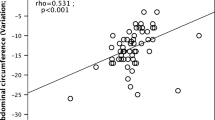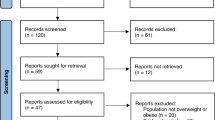Abstract
OBJECTIVE: To evaluate the safety and efficacy of Sibutramine 10 mg per os, once a day in obese patients over a period of 6 months.
DESIGN: A monocenter, double-blind, placebo-controlled, parallel, prospective clinical trial.
SUBJECTS: 109 male and female obese patients (BMI>30 kg/m2) from 16 to 65 y entered the trial.
MEASUREMENTS: Body weight, body mass index (BMI), waist and waist/hip ratio, medical history, assessment of hunger, satiety and diet compliance, standard laboratory assessments, blood pressure, heart rate and ECG.
RESULTS: 40 out of 55 patients in the Sibutramine group and 44 out of 54 patients in the placebo group completed the trial. Using the method of last observation carried forward (LOCF), the weight loss in the Sibutramine group was 7.52 kg (95% confidence intervals (95% CI) 6.15; 8.9) and that in the placebo group was 3.56 kg (95% CI 2.41; 4.7). The BMI loss was 3.14 kg/m2 (95% CI 2.58; 3.69) in the Sibutramine group and 1.46 kg/m2 (95% CI 0.99; 1.93) in the placebo group. The waist reduction was 12.51 cm (95% CI 9.25; 15.77) in the Sibutramine group and 3.26 cm (95% CI 1.38; 5.14) in the placebo group (P<0.05 by paired Student's t-test for all the intragroup comparisons). 32 Sibutramine patients had 45 adverse events, the most frequent adverse events in the Sibutramine group being dry mouth (n=19), increase in blood pressure (n=5), constipation (n=5) and tachycardia (n=5); 23 placebo patients had 29 adverse events, mainly increase in blood pressure (n=11) and dry mouth (n=10). Two Sibutramine patients withdrew from the trial due to adverse events.
CONCLUSION: Sibutramine induces significant loss of body weight, BMI and waist, but does not significantly affect cardiovascular function. Sibutramine was well tolerated by most of the patients.
This is a preview of subscription content, access via your institution
Access options
Subscribe to this journal
Receive 12 print issues and online access
$259.00 per year
only $21.58 per issue
Buy this article
- Purchase on Springer Link
- Instant access to full article PDF
Prices may be subject to local taxes which are calculated during checkout


Similar content being viewed by others
References
World Health Organisation . Report of WHO study group: Diet, nutrition and the prevention of chronic diseases. Technical Report Service 797. WHO: Geneva 1990.
Kuczmarski RJ, Carrol MD, Flegal KM, Troiano RP . Varying body mass index cut-off points to describe overweight prevalence among U.S. adults: NHANES III (1988 to 1994) Obes Res 1997 5: 542–548.
World Health Organisation . Obesity epidemic puts millions at risk from related diseases. Press Release WHO/46, 12 June 1997.
Pi-Sunyer FX . Medical Hazards of obesity Ann Intern Med 1993 119: 655–660.
Colditz GA, Willet WC, Stampfer MJ, Manson JE, Hennekens CH, Arky RA, Speizer FE . Weight as a risk factor for clinical diabetes in women Am J Epidemiol 1990 132: 501–513.
Hubert HB, Feinleib M, McNamara PM, Castelli WP . Obesity as independent risk factor for cardiovascular disease: A 26-year follow-up of participants in the Framingham Heart Study Circulation 1983 67: 968–977.
Rexrode KM, Hennekens CH, Willett WC, Colditz GA, Stampfer MJ, Rich-Edwards JW, Speizer FE, Manson JE . A prospective study of body mass index, weight change, and risk of stroke in women JAMA 1997 277: 1539–1545.
Pi-sunyer XA . A review of long-term studies evaluating the efficacy of weight loss in ameliorting disorders associated with obesity Clin Ther 1996 18: 1006–1036.
Stern JS, Hirsch J, Blair SN, Foreyt JP, Frank A, Kumanyika SK, Madans JH, Marlatt GA, St Jeor ST, Stunkard AJ . Weighing the options: Criteria for evaluating weight-management programs. The Committee to Develop Criteria for Evaluating the Outcomes of Approaches to Prevent and Treat Obesity Obes Res 1995 3: 591–604.
DePue JD, Clark MM, Ruggiero L, Medeiros ML, Pera V Jr . Maintenace of weight loss: A needs assessment Obes Res 1995 3: 241–248.
Expert panel on the Identification, Evaluation and Treatment of overweight in Adults. Pi Sunyer FX, Becker DM, Bouchard C, Carleton RA, Colditz GA, Dietz WH, Foreyt JP, Garrison RJ, Grundy SM, Hansen BC, Higgins M, Hill JO, Howard BV, Kuczmarski RJ, Kumanyika S, Legako RD, Prewitt TE, Rocchini AP, Smith PL, Snetselaar LG, Sowers JR, Weintraub M, Williamson DF, Wilson GT, Brown CD, Donato KA, Ernst N, Hill DR, Horan MJ, Hubbard VS, Kiley JP, Obarzanek E, Schriger D, Chiquette E . Clinical guidelines on the identification, evaluation, and treatment of overweight and obesity in adults: Executive summary Am J Clin Nutr 1998 68: 899–971.
National Task Force on the Prevention and Treatment of Obesity . Long-term Pharmacotherapy in the management of obesity JAMA 1996 276: 1907–1915.
Stock MJ . Sibutramine: A review of the pharmacology of a novel anti-obesity agent Int J Obes 1997 21 (Suppl 1): S25–S29.
Cole JO, Levin A, Beake B, Kaiser PE, Schienbaum ML . Sibutramine: a new weight loss agent without evidence of the abuse potential associated with amphetamines J Clin Psycopharmac 1998 18: 231–236.
Hansen DL, Toubro S, Stock MJ, Macdonald IA, Astrup A . Thermogenic effects of Sibutramine in humans Am J Clin Nutr 1998 68: 1180–1186.
Weintraub M, Rubio A, Golik A, Byrne L, Scheinbaum ML . Sibutramine in eight control: a dose-ranging efficacy study Clin Pharmac Ther 1991 50: 330–337.
Bray GA, Ryan DH, Gordon D, Heidingfelder S, Cerise F, Wilson K . A double-blind randomized placebo-controlled trial of Sibutramine Obes Res 1996 4: 263–270.
Hanotin C, Thomas F, Jones SP, Leutenegger E, Drouin P . Efficacy and tolerability of Sibutramine in obese patients: A dose-ranging study Int J Obes Relat Metab Disord 1998 22: 32–38.
Glantz SA . What does ‘not significant’ really mean? InPrimer of biostatistics, 3rd edn, Chap 6. McGraw-Hill: New York 1992 pp 155–187.
Williamson DF . Pharmcotherapy for obesity JAMA 1999 281: 278–280 (editorial).
Norusis MJ . Multiple linear regression analysis. InSPSS for Windows based system, user's guide, Release 6.0. SPSS: Chicago, Il 1993 pp 311–376.
Lean MEJ . Sibutramine—a review of clinical efficacy Int J Obes 1997 21 (Suppl 1): S30–S35.
Acknowledgements
We want to thank Miss Lucila Velasco for reviewing the manuscript. This Study was supported by Quimica Knoll de Mexico, Mexico City, Mexico.
Author information
Authors and Affiliations
Rights and permissions
About this article
Cite this article
Fanghänel, G., Cortinas, L., Sánchez-Reyes, L. et al. A clinical trial of the use of Sibutramine for the treatment of patients suffering essential obesity. Int J Obes 24, 144–150 (2000). https://doi.org/10.1038/sj.ijo.0801098
Received:
Revised:
Accepted:
Published:
Issue Date:
DOI: https://doi.org/10.1038/sj.ijo.0801098
Keywords
This article is cited by
-
Assessment of redox state and biochemical parameters of salivary glands in rats treated with anti-obesity drug sibutramine hydrochloride
Clinical Oral Investigations (2022)
-
Value of Weight Reduction in Patients with Cardiovascular Disease
Current Treatment Options in Cardiovascular Medicine (2010)
-
Influence of Sibutramine on blood pressure: evidence from placebo-controlled trials
International Journal of Obesity (2005)
-
Sibutramine and the sympathetic nervous system in obese humans
Clinical Autonomic Research (2005)
-
Use of sibutramine in obese hispanic adolescents
Advances in Therapy (2005)



